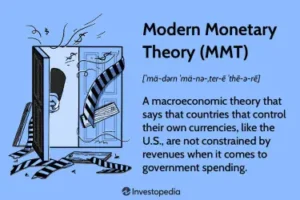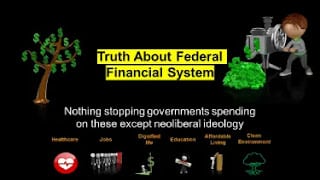Description
Uncover the truth about Australia’s sovereign currency. Learn why comparing federal finance to a household budget is misleading.
Introduction
In a world where financial literacy is paramount, the analogy comparing Australia’s federal financial system to a household budget persists in political and media narratives. This simplification, while appealing, masks the nuanced reality of how a sovereign currency issuer works. This article demystifies the federal financial system, explaining the unique position of the Australian government, which, unlike households, can issue its own currency – the Australian Dollar (A$).
The Household Budget Myth
The Perpetuation of a Financial Fallacy

The narrative that equates the Australian federal financial system to a household budget is not just a simplification; it is a strategic falsehood perpetuated by governments and accepted by the public. This analogy serves multiple purposes, both political and psychological, making it a powerful tool in shaping fiscal policy debates.
Why Governments Push This Falsehood

1. Political Expediency:
– The household budget analogy is politically helpful. It simplifies complex economic principles into a narrative that is easily understood by the public. By doing so, politicians can argue for fiscal austerity measures—such as spending cuts and balanced budgets—as if they were as prudent and necessary for the country as they are for individual households. This simplification allows for easier communication with voters who might not have a deep understanding of economic principles.
2. Control Over Public Spending:
– By convincing the public that the government must “live within its means,” politicians can more easily justify the prioritization of certain expenditures over others. This often results in the reduction of funding for social programs under the guise of fiscal responsibility. It also allows for the narrative that tax cuts, particularly for higher income brackets or corporations, are justified as necessary to balance the budget.
3. Avoiding Inflation Fears:
– Politicians often use the analogy to ward off concerns about inflation that theoretically could result from “excessive” government spending. By likening the government budget to a household budget, they imply that spending beyond income (tax revenue) would lead to debt that could trigger inflationary pressures, even though sovereign currency issuers like Australia face different economic constraints. This oversimplifies the dynamics of national economic management and downplays the government’s ability to manage inflation through other means.
Why the Public Readily Accepts This View
1. Intuitive Understanding:
– The household budget analogy aligns with the personal financial experiences of most individuals. People are accustomed to balancing their own budgets—ensuring they do not spend more than they earn—and thus, the analogy resonates on a personal level, making it an easy sell. This intuitive appeal makes the analogy a powerful tool for influencing public opinion on fiscal matters.
2. Lack of Economic Education:
– There is a general lack of comprehensive economic education among the public, which means that more complex explanations of fiscal policy and monetary sovereignty are not widely understood or given. This gap in understanding makes the simplistic household analogy more appealing and less contested. Without a robust foundation in economic principles, the public is more likely to accept simplified explanations that fit their personal experiences.
3. Media Reinforcement:
– Mainstream media often echoes the government’s narrative, further entrenching the analogy in public discourse. The repetition of this narrative across various media platforms lends it credibility and makes it a dominant framework through which fiscal policy is discussed and understood. Media outlets, driven by the need for simple, compelling stories, often prefer this straightforward analogy to more complex and correct economic explanations.
4. Fear of Debt:
– Culturally, debt is often viewed negatively, and the idea of living beyond one’s means is frowned upon. This societal norm makes the public more susceptible to accepting the idea that the government should also avoid debt, without understanding the different economic implications of government debt versus personal debt. The fear of debt is a powerful motivator that politicians can use to gain support for austerity measures.
The Impact on Critical Issues
The Impact of Fiscal Misconceptions on Critical Issues
The perpetuation of the household budget analogy by governments not only simplifies complex economic realities but also strategically supports the implementation of austerity measures. These measures, often justified as necessary for fiscal responsibility, have far-reaching consequences on society’s most pressing issues, from healthcare and education to environmental sustainability and social welfare.
The Purpose of Austerity Measures
1. Reducing Government Debt:
– Austerity measures are often presented to reduce national debt, with the government likening itself to a household that must tighten its belt during tough times. This narrative is compelling to voters who are accustomed to managing personal finances and can sympathize with the need to cut back on spending. However, this overlooks the fact that a sovereign government, unlike a household, can issue its own currency and does not rely on external income to finance its spending.
2. Shifting Economic Paradigms:
– By advocating for reduced government spending, politicians can shift the economic paradigm towards privatization and reduced public sector involvement. This aligns with neoliberal ideologies that favour market solutions over government interventions, often at the cost of dismantling social safety nets. The reduction in public spending can lead to increased inequality as private entities take over services that were once publicly funded and accessible to all.
3. Controlling Inflation:
– Governments claim that austerity is necessary to control inflation, suggesting that cutting spending is a prudent measure to prevent the economy from overheating. However, this oversimplifies the dynamics of inflation and ignores the role of fiscal policy in addressing demand shortfalls and unemployment. Responsibly managed, government spending can stimulate economic growth without necessarily leading to inflation, especially when there are underutilized resources in the economy.
Impact on Critical Issues
1. Healthcare and Education:
– Austerity measures often result in cuts to essential services like healthcare and education. The narrative that the government must save money leads to underfunded public institutions, affecting the quality of care and education available to the public. This disproportionately affects lower-income families who rely more heavily on these services. For instance, underfunded hospitals may struggle to provide prompt and adequate care, while schools may lack resources, leading to larger class sizes and fewer educational opportunities.
2. Environmental Sustainability:
– Fiscal conservatism, justified through the household budget analogy, limits investment in green technologies and sustainable infrastructure. The urgent need for environmental action is sidelined by concerns over government spending, delaying critical initiatives for climate change mitigation and adaptation. This short-term focus on reducing spending can have long-term detrimental effects on the environment, as necessary investments in renewable energy and conservation projects are postponed or cancelled.
3. Social Welfare:
– The push for austerity often leads to reductions in social welfare programs, including unemployment benefits, housing aid, and food subsidies. The narrative that the government must cut back spending to “live within its means” sacrifices the well-being of the most vulnerable populations, worsening inequality, and social injustice. Programs designed to support those in need during times of economic hardship are often the first to be cut, leading to increased poverty and social instability.
Limiting Public Understanding and Engagement
The simplification of fiscal policy into a household budget analogy not only misleads the public about the government’s financial capabilities but also strategically limits public engagement with fiscal policy debates. By framing the discussion around the need for austerity, the government discourages deeper inquiry into alternative economic policies that could more effectively address societal needs. This deliberate smokescreen serves to support the status quo, where economic policies favour corporate interests and the wealthy, further entrenching economic and social disparities.
Embracing Modern Monetary Theory (MMT)
By embracing the principles of Modern Monetary Theory (MMT), we can shift the discourse towards how responsibly using Australia’s monetary sovereignty could transform societal and environmental outcomes. MMT offers a lens through which to view currency issuance and spending not as bound by revenue but by the economy’s ability to absorb spending without triggering inflation.
Reasons for Misrepresentation
1. Complexity:
– The simplicity of the household analogy is politically expedient, reducing complex economic policies to easily digestible soundbites. Explaining the nuances of MMT and sovereign currency issuance requires a deeper understanding and a willingness to engage with more complex ideas, which can be challenging in a political landscape that favours quick and easy solutions.
2. Political Agenda:
– Aligning the federal budget with household finances supports narratives that justify spending cuts and fiscal conservatism. This serves political agendas that prioritize reducing the size of government, cutting taxes, and limiting public spending. By supporting this analogy, politicians can continue to push for policies that align with neoliberal economic principles, even if they are not in the best interest of the broader population.
3. Economic Convention:
– Traditional economic theories have long influenced public and academic discourse, making alternative perspectives like MMT less visible. These established theories often focus on balanced budgets and controlling inflation through limited government spending, overlooking the potential benefits of practical fiscal policy in addressing economic and social issues.
Embracing Modern Monetary Theory (MMT) and Overcoming Misinformation

Convincing the public to embrace Modern Monetary Theory (MMT) and overcome years of conditioning by misinformation requires a multifaceted approach. This approach must educate, engage, and empower individuals and communities to rethink the federal financial system’s capabilities.
Simplify Economic Education
Break down MMT and its implications into easily understandable concepts. Use analogies that accurately reflect the government’s monetary capabilities, contrasting them with the limitations of household budgets. Educational content should be accessible through various mediums, such as videos, infographics, and simple texts, to reach a broad audience.
Leverage Social Media and Influencers
Social media platforms and influencers can play a crucial role in spreading awareness about MMT. By engaging with popular figures who support MMT and its principles, the theory can be introduced to a wider, younger audience that may be more open to challenging traditional economic narratives.
Public Forums and Discussions
Organize public forums, webinars, and discussion panels featuring economists, policymakers, and academics who can explain MMT’s benefits and address common misconceptions. These events can provide a platform for open dialogue, allowing the public to ask questions and engage directly with experts.
Policy Demonstrations and Case Studies
Real-world examples where principles aligned with MMT have been successfully applied, even if not explicitly under the MMT banner directed towards public goods and services, have stimulated economic growth, and improved societal well-being without leading to uncontrollable inflation or financial ruin.
Here are some examples:
1. The New Deal (1930s – 1940s): Implemented by President Franklin D. Roosevelt, this program aimed to lift the United States out of the Great Depression. It involved massive government spending on public works projects, infrastructure, and social programs, leading to economic recovery and the creation of millions of jobs.
2. Post-World War II Reconstruction in Europe: The Marshall Plan, started by the United States, injected significant funds into war-torn European economies for reconstruction and development. This aid played a crucial role in Europe’s recovery and economic revitalization.
3. Australia’s Response to the Global Financial Crisis (2008): The Australian government, under Prime Minister Kevin Rudd, implemented a stimulus package that included infrastructure spending, cash handouts, and subsidies. This helped Australia avoid a recession and support economic growth during a global downturn.
4. Job Guarantee Programs: Various countries and regions have experimented with job guarantee programs, where the government offers employment to anyone willing and able to work at a basic wage. These programs provide stability, reduce unemployment, and stimulate economic activity.
5. Green New Deal Proposals: Advocates for a Green New Deal propose large-scale government investment in renewable energy, infrastructure, and sustainable industries to address climate change while creating jobs and stimulating economic growth.
These examples show how strategic government spending can stimulate economic activity, create employment, and improve societal well-being without causing uncontrollable inflation or financial instability.
Political Advocacy
Support and promote political candidates and parties that understand and advocate for policies consistent with MMT. Political advocacy can also involve lobbying for the inclusion of MMT principles in policy discussions and economic planning, emphasizing the theory’s potential to address unemployment, inequality, and environmental challenges.
Community Engagement
Engage with community groups and organizations to discuss how MMT can directly help local projects and initiatives. By showing the practical implications of MMT for funding public infrastructure, healthcare, education, and environmental projects, communities can become advocates for change.
Addressing Inflation Concerns
Clearly communicate how MMT accounts for inflation risks through targeted spending and resource allocation. By explaining the mechanisms for managing inflation within the MMT framework, the public can better understand how fiscal policy can be both ambitious and responsible.
Creating Educational Partnerships
Collaborate with educational institutions to integrate modern economic theories, including MMT, into curricula. By educating the next generation of economists, policymakers, and citizens about MMT, the groundwork is laid for a more informed public discourse on fiscal policy.
Conclusion
Understanding the true nature of Australia’s financial system is the first step towards advocating for policies that can genuinely improve our society and environment. It is time for voters to demand transparency and honesty from politicians and the media about what is financially possible.
Call to Action
Join the conversation on fiscal policy reform. Educate, engage, and empower others to challenge the status quo.
Questions for Readers
How can individuals contribute to the healing and reconciliation process for Australia’s First Nations People?
References and Evidence:
Governor of RBA Creating Money Out of Thin Air: https://drive.google.com/file/d/1n9e_9ojRTMLqp304D76hpxD3JE8f0ppP/view?usp=sharing
The Conversation – “Explainer: what is modern monetary theory?”
An accessible introduction to Modern Monetary Theory (MMT), discussing its key principles and implications for fiscal policy.
The Conversation: https://theconversation.com/explainer-what-is-modern-monetary-theory-72095
Reserve Bank of Australia (RBA) – “Speeches”
Speeches by RBA officials often touch on aspects of monetary policy, fiscal policy, and the Australian economy, providing insights into current economic thinking and policy approaches.
RBA Speeches: https://www.rba.gov.au/speeches/
4. Australian Bureau of Statistics (ABS) – “National Accounts”
Provides data on Australia’s economic performance, including government spending, which can be used to discuss the impact of fiscal policies.
ABS National Accounts: https://www.abs.gov.au/statistics/economy/national-accounts
The Conversation – “Modern monetary theory: the rise of economists who say huge government debt is not a problem”.
An article discussing the rise of MMT and how it challenges conventional views on government debt and fiscal policy.
The Conversation: https://theconversation.com/modern-monetary-theory-the-rise-of-economists-who-say-huge-government-debt-is-not-a-problem-141495
Journal of Post Keynesian Economics
While specific articles may require access through academic institutions, abstracts and some open-access articles can provide scholarly perspectives on MMT and fiscal policy debates.
Taylor & Francis Online: https://www.tandfonline.com/toc/mpke20/current
Australian Government – Department of Finance – “Budget”
Official budget documents and analyses offer insights into the government’s fiscal strategy, spending priorities, and economic forecasts.
Australian Government Budget: https://budget.gov.au/
ABC News – “What is Modern Monetary Theory, and could it fix Australia’s economy?”
An article that explains MMT in the context of Australia’s economy, discussing how it could address economic challenges.
ABC News: https://www.abc.net.au/news/2019-10-22/modern-monetary-theory-explained/11624108
Economic Analysis and Policy – “Modern Monetary Theory and the public purpose”
A peer-reviewed article discussing MMT’s approach to fiscal policy and its implications for public welfare and economic stability.
Elsevier: https://www.journals.elsevier.com/economic-analysis-and-policy
The Conversation – “Explainer: what is modern monetary theory?”
There is a school of thought among economists who aren’t worried about the so called “budget black hole”, where tough choices have been called for to reduce government spending.
The Conversation: https://theconversation.com/explainer-what-is-modern-monetary-theory-72095
Reserve Bank of Australia (RBA) – “Bulletin”
The RBA Bulletin provides detailed analyses of various aspects of the Australian economy, including discussions relevant to fiscal policy and monetary theory.
RBA Bulletin: https://www.rba.gov.au/publications/bulletin/
Additional References and Evidence:
The Deficit Myth: Modern Monetary Theory and the Birth of the People’s Economy” by Stephanie Kelton. This book is a foundational text for understanding MMT and its implications for fiscal policy, debunking common myths about government deficits and financial sustainability.
The Deficit Myth: https://www.booktopia.com.au/the-deficit-myth-stephanie-kelton/book/9781529352566.html
Reclaiming the State: A Progressive Vision of Sovereignty for a Post-Neoliberal World” by William Mitchell and Thomas Fazi. This work explores the role of the state in the economy and how neoliberal policies have undermined public services and welfare.
Australian Government Treasury Reports and Budget Outlines: Official government documents provide insight into current fiscal policies, spending, and economic outlooks, serving as a baseline for discussing alternatives offered by MMT.
Treasury Annual Report 2022-23: https://treasury.gov.au/publication/p2023-454036
Macroeconomics” by William Mitchell, L. Randall Wray, and Martin Watts. This textbook offers a comprehensive overview of macroeconomic theory, including chapters that explain the principles of MMT in detail.
Macroeconomics: https://www.booktopia.com.au/macroeconomics-william-mitchell/book/9781137610669.html
The Conversation, Articles on MMT: The Conversation features accessible articles by academics and economists on MMT, its principles, and potential applications in Australia and beyond.
Articles on modern monetary theory: https://theconversation.com/global/topics/modern-monetary-theory-35017
Reserve Bank of Australia (RBA) Publications: The RBA’s discussions on monetary policy, inflation, and economic conditions in Australia provide empirical data to address concerns about inflation and the role of government spending.
What is Monetary Policy?: https://www.rba.gov.au/education/resources/explainers/what-is-monetary-policy.html
Journal of Post Keynesian Economics: This journal offers peer-reviewed articles that include discussions on MMT and its critiques, providing a scholarly perspective on the theory.
Fiscal Policy and Management in East Asia”, NBER-East Asia Seminar on Economics, Volume 16: This collection provides comparative studies on fiscal policy in different economies, offering evidence on the effects of various fiscal strategies.
Fiscal Policy and Management in East Asia: https://www.amazon.com/Management-National-Economic-Research-Economics/dp/0226386813
Australian Bureau of Statistics (ABS): The ABS provides data on unemployment, inflation, and economic growth, which can be used to argue the real-world implications of fiscal policies.
Employment and unemployment: https://www.abs.gov.au/statistics/labour/employment-and-unemployment
Why Minsky Matters: An Introduction to the Work of a Maverick Economist” by L. Randall Wray: This book provides insight into Hyman Minsky’s work, which has influenced MMT, especially regarding financial stability and the role of government spending.
Why Minsky Matters: https://www.amazon.com.au/Why-Minsky-Matters-Introduction-Economist-ebook/dp/B00XNZA8CO

